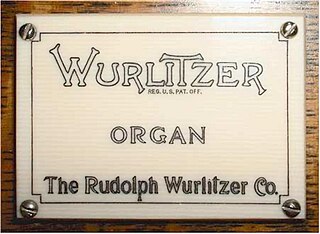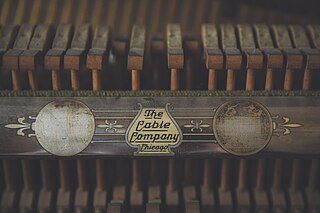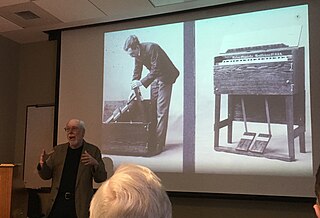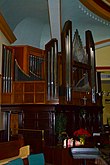
Lyon & Healy Harps, Inc. is an American musical instrument manufacturer based in Chicago, Illinois and is a subsidiary of Salvi Harps. Today best known for concert harps, the company's Chicago headquarters and manufacturing facility contains a showroom and concert hall. George W. Lyon and Patrick J. Healy began the company in 1864 as a sheet music shop. By the end of the 19th century, they manufactured a wide range of musical instruments—including not only harps, but pianos, guitars, mandolins, banjos, ukuleles and various brass and other percussion instruments.

A player piano, also known as a pianola, is a self-playing piano with a pneumatic or electro-mechanical mechanism that operates the piano action using perforated paper or metallic rolls. Modern versions use MIDI. The player piano gained popularity as mass-produced home pianos increased in the late 19th and early 20th centuries. Sales peaked in 1924 and subsequently declined with improvements in electrical phonograph recordings in the mid-1920s. The advent of electrical amplification in home music reproduction, brought by radios, contributed to a decline in popularity, and the stock market crash of 1929 virtually wiped out production.

In music, the organ is a keyboard instrument of one or more pipe divisions or other means for producing tones. The organs have usually two or three, up to five, manuals for playing with the hands and a pedalboard for playing with the feet. With the use of registers, several groups of pipes can be connected to one manual.

A free reed aerophone is a musical instrument that produces sound as air flows past a vibrating reed in a frame. Air pressure is typically generated by breath or with a bellows. In the Hornbostel–Sachs system, it is number: 412.13. Free reed instruments are contrasted with non-free or enclosed reed instruments, where the timbre is fully or partially dependent on the shape of the instrument body, Hornbostel–Sachs number: 42.

A piano roll is a music storage medium used to operate a player piano, piano player or reproducing piano. Piano rolls, like other music rolls, are continuous rolls of paper with holes punched into them. These perforations represent note control data. The roll moves over a reading system known as a tracker bar; the playing cycle for each musical note is triggered when a perforation crosses the bar.

Rodgers Instruments Corporation is an American manufacturer of classical and church organs. Rodgers was incorporated May 1, 1958 in Beaverton, Oregon by founders, Rodgers W. Jenkins and Fred Tinker, employees of Tektronix, Inc., of Portland, Oregon, and members of a Tektronix team developing transistor-based oscillator circuits. Rodgers was the second manufacturer of solid state oscillator-based organs, completing their first instrument in 1958. Other Rodgers innovations in the electronic organ industry include solid-state organ amplifiers (1962), single-contact diode keying (1961), reed switch pedal keying for pedalboards (1961), programmable computer memory pistons (1966), and the first MIDI-supported church organs (1986).

An electric organ, also known as electronic organ, is an electronic keyboard instrument which was derived from the harmonium, pipe organ and theatre organ. Originally designed to imitate their sound, or orchestral sounds, it has since developed into several types of instruments:

The Rudolph Wurlitzer Company, usually referred to as simply Wurlitzer, is an American company started in Cincinnati in 1853 by German immigrant (Franz) Rudolph Wurlitzer. The company initially imported stringed, woodwind and brass instruments from Germany for resale in the United States. Wurlitzer enjoyed initial success, largely due to defense contracts to provide musical instruments to the U.S. military. In 1880, the company began manufacturing pianos and eventually relocated to North Tonawanda, New York. It quickly expanded to make band organs, orchestrions, player pianos and pipe or theatre organs popular in theatres during the days of silent movies.

The pump organ or reed organ is a type of free-reed organ that generates sound as air flows past a vibrating piece of thin metal in a frame. The piece of metal is called a reed. Specific types of pump organ include the American reed organ, the Indian harmonium, the physharmonica, and the seraphine. The idea for the free reed was derived from the Chinese sheng through Russia after 1750, and the first Western free-reed instrument was made in 1780 in Denmark.

Mason & Hamlin is a piano manufacturer based in Haverhill, Massachusetts. Founded in 1854, they also manufactured a large number of pump organs during the 19th century.

Chord organ is a kind of home organ that has a single short keyboard and a set of chord buttons, enabling the musician to play a melody or lead with one hand and accompanying chords with the other, like the accordion with a set of chord buttons which was originated from a patent by Cyrill Demian in 1829, etc.

M. Welte & Sons, Freiburg and New York was a manufacturer of orchestrions, organs and reproducing pianos, established in Vöhrenbach by Michael Welte (1807–1880) in 1832.

Kimball International consists of furniture brands: Kimball, National, Interwoven, Etc., David Edward, D'Style and Kimball Hospitality. It is the successor to W.W. Kimball and Company, the world's largest piano and organ manufacturer at certain times in the 19th and 20th centuries.

Richard Simonton (1915–1979), also known under the pseudonym Doug Malloy, was a Hollywood businessman and entrepreneur, known for his involvement in the Hollywood community, his rescue of the steamboat Delta Queen, his work in preserving the work of musicians in the Welte-Mignon piano rolls and for founding the American Theatre Organ Society. Among piercing enthusiasts he is also known as an early pioneer of the contemporary resurgence in body piercing.

Sohmer & Co. was a piano manufacturing company founded in New York City in 1872. Sohmer & Co. marketed the first modern baby grand piano, and also manufactured pianos with aliquot stringing and bridge agraffes, as well as Cecilian "all-inside" player pianos and Welte-Mignon-Licensee reproducing pianos. Sohmer pianos were owned by U.S. President Calvin Coolidge, and composers Victor Herbert and Irving Berlin. Sohmer is now a line of pianos manufactured by Samick Music Corporation in Korea.

Harald Bode was a German engineer and pioneer in the development of electronic musical instruments.

Levi Knight Fuller was the 44th governor of Vermont from 1892 to 1894.

The Cable Company was an American manufacturer and distributor of pianos and reed organs that operated independently from 1880 to 1936.

Edwin Scott Votey was an American businessman, inventor, industrial designer, and manufacturer of pianos and organs. He worked in the organ field all his adult life and had over twenty patents. He invented or co-invented several inventions for World War I. One was a pilotless airplane that was going to be used to drop bombs on the enemy but was never used.

Dennis Waring is a multi-instrumentalist musician, teacher, historian and ethnomusicologist who was the Connecticut State Troubadour from 2003 through 2004. He wrote a history book on the Estey Organ Company titled Manufacturing the Muse: Estey Organs & Consumer Culture in Victorian America, based on his 1987 doctoral dissertation at Wesleyan University, where he was curator of a world instrument workshop while a graduate student.







































